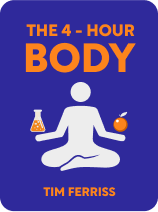

This article is an excerpt from the Shortform book guide to "The 4-Hour Body" by Timothy Ferriss. Shortform has the world's best summaries and analyses of books you should be reading.
Like this article? Sign up for a free trial here .
What is strength training for athletes? How does The 4-Hour Body recommend athletes complete strength training?
Strength training for athletes is a program for building muscle without compromising your sports-specific skills. You want to enhance and prioritize your sports performance.
Read on for The 4-Hour Body approach to strength training for athletes.
Strength Training for Athletes
There are some principles to keep in mind for strength training for athletes:
Principle #1: Train your sport-specific skills six days a week, do sports-related training (such as conditioning) three days a week, and do strength training three days a week on the days you’re not doing sports-related training. (In Part 2, we learned that training less frequently is effective for building strength, but as athletes have more complicated goals than simply getting stronger, they should train more than once a week.)
Principle #2: Sets should only contain two or three reps. Total reps should number around 10, whether that’s five sets of two or three sets of three.
Principle #3: Do only a few exercises that target most of the bodies’ muscle groups, such as the bench press or deadlift.
Principle #4: Spend five minutes resting in between all sets.
Principle #5: Don’t push to failure (being so fatigued you can’t do any more reps).
Principle #6: You should feel stronger after lifting than when you started.
Principle #7: Do the Janda sit-up to strengthen your abs. According to scientific theories, Janda sit-ups are effective because they force you to contract your hamstrings, which turns off your hip flexors and forces your abs to do all the work (people often cheat at abs by recruiting their hip flexors for help). To do the exercise:
- Sit on the ground and wrap a towel or resistance band around your calves. Ask a training partner to pull on the towel at a 45-degree angle, or wrap the band around something high like a door handle to get the same 45-degree angle.
- Pull your belly button towards your tailbone.
- Sit up without letting your legs move. If you can’t do this, which is normal, sit up however you need to and do only the lowering part of the sit-up without letting your legs move.
All of the above principles are based around the idea that you should lift heavy weights but not do anything too hard. While strength training is important for athletes for a variety of reasons, developing strength is never the priority: skill development is. Therefore, your strength training should never interfere with the practice of your sport, for example, by making you too sore to practice.
- For example, Wimbledon star Maria Sharapova’s strength training only included small sets of pull-ups, one-legged squats, push-ups, and Janda sit-ups.
The Benefits of Shorter Training Sessions
You might find it counterintuitive that strength training for athletes is just a few exercises for short periods, but there’s plenty of evidence to show that working harder for a shorter period creates the same or better results than working less hard for longer.
For example, in 2005, Martin Gibala, a researcher at McMaster University, publicized the results of a study that indicated that doing six minutes of high-intensity exercise three times weekly was just as good as doing an hour a day of moderate exercise. In his study, one group did 30-second stationary bike sprints four to sevens times, with four minutes of rest in between. They did this workout three times weekly for two weeks, while a control group did an hour of moderate exercise a day. The sprint group almost doubled their endurance capacity and their leg muscles developed more endurance enzymes. When the test was repeated with similar workouts the results were the same.

———End of Preview———
Like what you just read? Read the rest of the world's best book summary and analysis of Timothy Ferriss's "The 4-Hour Body" at Shortform .
Here's what you'll find in our full The 4-Hour Body summary :
- How to do the least amount you need to do for the results you want
- Why you need a cheat day in your diet
- How to improve everything about your body, including sleep, sex, and longevity






